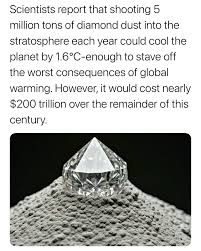Diamond Dust Geoengineering Proposed to Counter Global Warming
Why in the news?
Scientists suggest dispersing diamond dust in the atmosphere could reduce global temperatures by 1.6°C, offering a safer alternative to current geoengineering methods but with significant cost and ecological concerns.
About the Diamond Dust Geoengineering:
- A new study explores diamond dust as a geoengineering approach to mitigate global warming by cooling Earth’s climate.
- Proposal: Dispersing about 5 million tonnes of diamond dust into the upper atmosphere yearly over 45 years, which could reduce global temperatures by roughly6°C.
- Diamond dust has benefits over sulphur dioxide for cooling, as it reflects sunlight, remains airborne longer, and is chemically stable, avoiding harmful side effects like acid rain or ozone depletion.
Understanding Geoengineering Approaches:
- Geoengineering (or climate engineering) includes large-scale methods designed to counteract global warming impacts.
- There are two main approaches:
- Carbon Dioxide Removal (CDR): Reduces CO₂ in the atmosphere, either by boosting carbon sinks or through direct CO₂
- Solar Radiation Management (SRM): Reflects sunlight away from Earth to reduce heat absorption, with techniques like stratospheric aerosol injection and marine cloud brightening.
Risks and Considerations for Geoengineering:
- Challenges: High costs, ecosystem impacts, and the risk of shifting focus from critical emissions reductions.
- Importance of Evaluation: While promising, geoengineering requires thorough risk assessment to balance its potential benefits against unintended environmental and social consequences.
- This underscores the need to consider geoengineering as a supplementary solution to conventional climate policies rather than a standalone fix.
Sources Referred:
PIB, The Hindu, Indian Express, Hindustan Times




